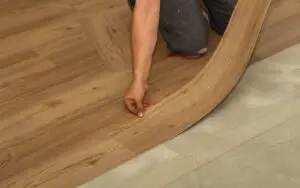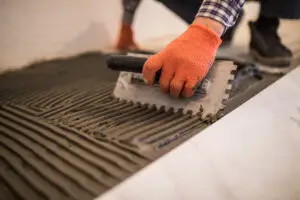Understanding the Basics of Hardwood Flooring
What is Hardwood Flooring?
Solid vs. Engineered Hardwood
Hardwood flooring is a popular choice for homeowners due to its beauty, durability, and timeless appeal. There are two main types of hardwood flooring: solid hardwood and engineered hardwood. Solid hardwood is made from planks milled from a single piece of wood, while engineered hardwood is made from multiple layers of wood with a hardwood veneer on top. Both options have their unique characteristics, advantages, and disadvantages.
Types of Wood Species
Hardwood flooring comes in a variety of wood species, each with its unique color, grain patterns, and hardness. Common options include oak, maple, cherry, and hickory. The wood species will have a large impact on the aesthetic, durability, and overall look of the floor. It’s always important to do your research on which species you want to install in your home.
Benefits of Choosing Hardwood
Aesthetic Appeal and Timeless Style
Hardwood flooring is valued for its natural beauty and timeless style. The unique grain patterns, warm tones, and classic look add a touch of elegance and sophistication to any home. Hardwood floors can complement any decor, and have been a classic option for decades.
Durability and Longevity
Hardwood flooring is known for its exceptional durability and long lifespan. With proper care and maintenance, it can last for generations, making it a wise investment for homeowners. The durability means that you will not have to replace your floors as often as you would with other options.
Increase in Home Value
Hardwood flooring is considered a desirable feature for many homebuyers and can increase the value of your home. Its timeless appeal and durability often make homes more attractive to prospective buyers. It is always important to consider how your flooring choices will affect the overall value of your property.
Drawbacks of Hardwood Flooring
Susceptibility to Moisture
One of the main drawbacks of hardwood flooring is its susceptibility to moisture. Water spills, humidity, and other moisture issues can cause damage, such as warping, cupping, and staining. It’s always important to consider the location of the floor, and choose your material accordingly.
Higher Cost Compared to Other Options
Hardwood flooring is typically more expensive than other flooring options in terms of both material and installation costs. This makes it less budget-friendly for some homeowners, which often means that a flooring project needs to be planned out carefully, and all options need to be evaluated thoroughly.
Required Maintenance
Hardwood flooring requires regular cleaning and maintenance to keep it looking its best. Regular cleaning, refinishing, and periodic maintenance is required to maintain its natural beauty and its longevity. The maintenance requirements are an important factor to consider.
Types of Hardwood Flooring
Solid Hardwood
Composition and Characteristics
Solid hardwood flooring is made from planks milled from a single piece of solid wood. This provides an authentic and classic look. Because each piece is milled from a solid piece of wood, it means that each plank has its own unique grain and pattern.
Installation Methods and Requirements
Solid hardwood flooring is typically installed by nailing or gluing it to a subfloor. This installation process requires specialized tools, knowledge, and experience. It is highly recommended to hire a professional installer, to ensure that the job is done correctly, and the warranty is upheld.
Engineered Hardwood
Composition and Advantages
Engineered hardwood flooring is made from multiple layers of wood, with a hardwood veneer on top. This construction provides greater stability and moisture resistance compared to solid hardwood. It also tends to be more affordable and can be installed easier and quicker than solid hardwood.
Suitable Applications
Engineered hardwood is suitable for a wider range of applications, including basements and kitchens, where moisture is a concern. This flexibility makes engineered hardwood a versatile option that can fit into any area of the home. The moisture resistance makes it a good option in areas that are prone to spills.
Common Wood Species and Their Properties
Oak, Maple, Cherry, and Hickory
Common wood species include oak, maple, cherry, and hickory, each with unique properties. Oak is known for its durability and classic grain pattern, while maple has a lighter color and smoother grain. Cherry is a reddish-brown with a rich hue, and hickory is one of the hardest and most durable wood species, making it a great option for high-traffic areas.
Considering Grain, Color, and Hardness
When choosing a wood species, consider the grain pattern, color, and hardness level. The grain will affect the aesthetic appeal, color will need to match the existing style, and the hardness will affect the durability. Professional installers can also help you choose the right wood species based on your style and your needs.
Installation and Maintenance of Hardwood
Preparing for Hardwood Installation
Subfloor Requirements and Preparation
Proper subfloor preparation is essential for a successful hardwood installation. The subfloor must be level, clean, and dry before installation begins. Any issues with the subfloor need to be addressed to ensure that your new floors are stable and properly supported.
Acclimation Process
Before installing hardwood flooring, it must be acclimated to the environment. This means allowing it to sit in the room for a period of time, to adjust to the temperature and humidity. This helps prevent issues like warping or cupping after installation. The time required for acclimation will be based on the manufacturer, and the local climate.
Steps for Professional Installation
Proper Techniques and Tools
Professional hardwood installation requires specific techniques and tools. This includes precise measurements, proper alignment of the planks, and the use of specialized tools such as nail guns and saws. Their knowledge and training help them to ensure that your floor is installed with the highest standard of quality.
Importance of a Seamless Finish
A seamless finish is crucial for both the appearance and the longevity of hardwood flooring. Professionals pay close attention to every detail to ensure that the floor looks uniform, without any visible gaps or flaws. A seamless finish is one of the most important factors for the overall beauty and style.
Regular Cleaning and Upkeep
Dusting, Sweeping, and Vacuuming
Regular dusting, sweeping, and vacuuming are necessary to keep hardwood floors clean and free of debris that can scratch the surface. This should be a regular part of your cleaning routine, and should be done weekly, to ensure your hardwood floor remains beautiful for years.
Recommended Cleaning Products
When cleaning hardwood floors, it’s important to use cleaning products that are recommended for hardwood, as harsh chemicals and excess water can damage the finish. Professional installers can also advise on the best cleaning products for your specific flooring type and finish.
Refinishing and Repairing Hardwood Floors
When to Refinish
Hardwood floors should be refinished when they show signs of wear and tear, such as scratches, dents, and a dull finish. How often you need to refinish will depend on the traffic levels of your home, and how well the floors are maintained. Refinishing is a great way to extend the life and beauty of your hardwood floors.
Methods for Refinishing
Refinishing typically involves sanding down the existing finish, applying a new stain, and applying a new sealant. Professional refinishing services can ensure that the refinishing is done correctly and that your floors look as good as new.
Making the Right Choice for Your Home
Considering Your Budget and Lifestyle
Balancing Cost and Needs
When choosing hardwood flooring, balance your budget with your specific needs. Solid hardwood is a premium choice, but engineered wood offers many of the same benefits at a lower cost. Considering your financial constraints and how long you plan to stay in your home, will help you choose the right flooring.
Choosing the Best Type for Your Space
Consider the space where you’ll install hardwood flooring. Solid hardwood is best for low-moisture areas, while engineered wood is suitable for a wider range of environments, including kitchens and basements. Consider each space and choose the correct product accordingly.
DIY vs Professional Installation: Which is Best?
Risks and Potential for Errors
DIY installation of hardwood flooring carries a significant risk of errors, including improper subfloor preparation, uneven plank placement, and damage to the floor. These errors can end up costing more to repair than the initial savings from not hiring a professional. By hiring a professional, you’re ensuring the job is done right the first time.
Benefits of Professional Installation
Professional installers have the expertise, tools, and experience to install hardwood floors correctly, and they will also provide a warranty on their work. Professional installation ensures that the job is done right, and gives you peace of mind knowing that your investment is protected.
Case Study: DIY vs Professional Hardwood Installation
Examples of Success and Failure
A homeowner decided to install their hardwood floors themselves to save money, but ended up with an uneven and flawed floor, due to a lack of experience, and ultimately had to pay for the cost of the professional repair. In contrast, another homeowner who hired a professional installer, had a beautiful hardwood floor that was installed properly, with no issues. This highlights the importance of hiring a professional for a seamless and successful outcome.
Impact on Cost and Quality
While DIY installations may seem like a more affordable option, they often result in a lower quality finish, and can end up costing more to repair. Professional installations may cost more upfront, but offer a higher quality finish and a longer-lasting product, ensuring you get the best value and a warranty for the finished product.
FAQs & Answers
The frequency of refinishing depends on the level of foot traffic, wear, and tear, but typically, hardwood floors need to be refinished every 7-10 years. Professional refinishing services can help ensure the proper care and extend the lifespan of your flooring. Hiring a professional will ensure that the refinishing is done right, and that you get the most out of your floor.
The best way to clean hardwood floors is by using a soft microfiber mop, or a vacuum, and using manufacturer-recommended cleaning solutions, while avoiding water. Professional flooring services can also provide advice on the best cleaning methods and products for your specific flooring type. This is something a professional installer will also discuss with you to ensure you have all of the knowledge you need.
Hardwood floors are suitable for homes with pets and children, but they can be more susceptible to scratches and dents. Regular maintenance, and using rugs in high-traffic areas, can help protect your hardwood floors. A professional installer can also advise you on types of finishes that may be best for your specific situation.
Solid hardwood is made from a single piece of wood, while engineered hardwood is made from multiple layers of wood with a hardwood veneer on top. Engineered wood is more resistant to moisture, while solid hardwood has more refinishing options, but both offer beauty, warmth, and durability. A professional can guide you through these options, and help you make the best decision for your needs and preferences.
Professional installation is highly recommended for hardwood flooring to ensure proper subfloor preparation, accurate plank placement, and a seamless finish. Professionals will also ensure the flooring is installed correctly, and covered by a warranty. This ensures that your investment is protected, and that the flooring will last for many years.





